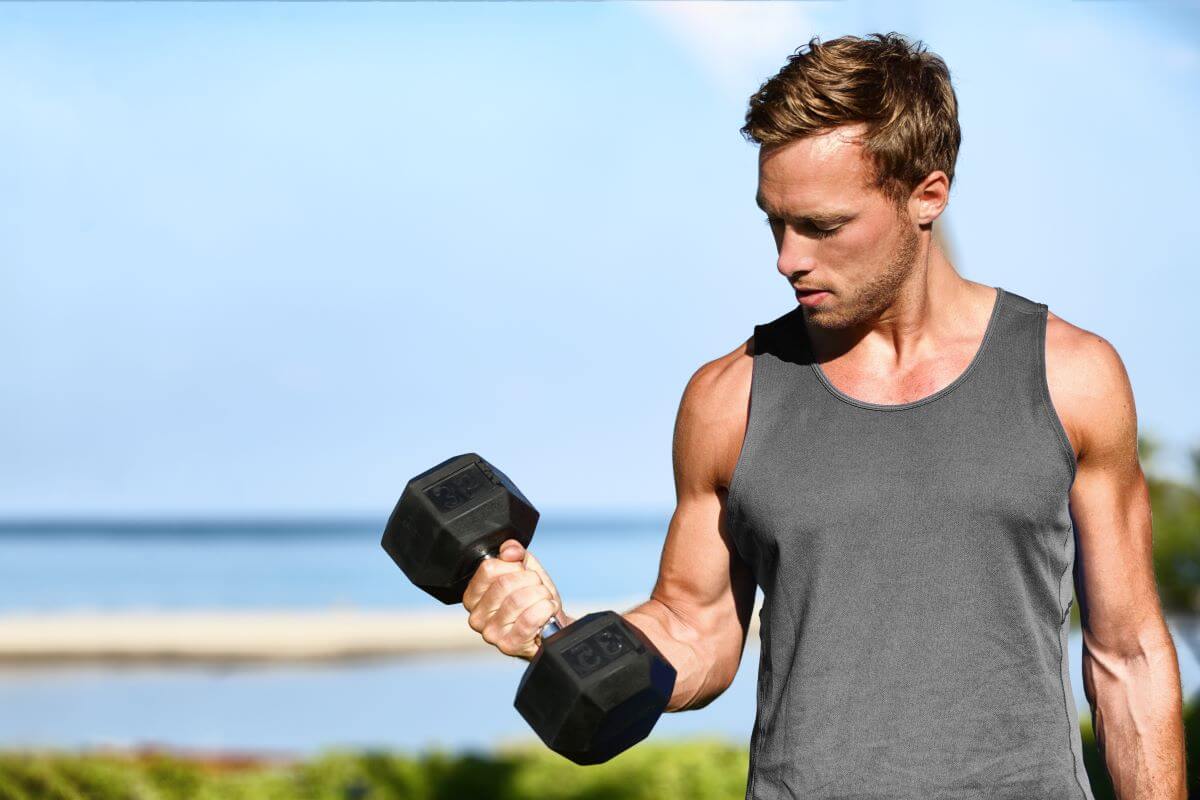The dumbbell curl is an exercise that is very near and dear to many lifters hearts.
With the dreams of building sleeve stretching arms, many of us turned to bicep curls to accomplish this goal.
And, to an extent, this basic exercise has helped many over the years build bicep muscle mass.
With that said, there’s some key components to the exercise that everyone should know to get the most out of performing dumbbell bicep curls.
In this article, we are going to break down how to perform the exercise, what muscle groups the exercise targets, when in your workout to perform it, how many reps and sets to do, as well as provide a list of variations for you to consider adding to your workout routines.
How to Perform Dumbbell Curls
The first thing you will need to decide for yourself is if you would rather perform dumbbell curls in a standing position or in a seated position.
Either is fine and both have their own benefits.
For those who perform the exercise standing, you’ll add core stability to the exercise. Those who perform the exercise seated will be able to focus on directly targeting the biceps. Standing allows you to go slightly heavier as you can use some moderate momentum to carry the weight, while seated makes it more difficult to perform cheat reps.
Once you have decided on your preferred setup, follow the steps below to perform a dumbbell curl:
- Select the desired weight you would like to use to perform the exercise.
- Hold a dumbbell in each hand with your arms hanging by your side.
- At the start of the exercise, keep your hands in a neutral position.
- Flexing your bicep, bend your elbow while turning your wrist into a supinated position (palms facing up).
- Continue to flex your bicep as you bring the weight to the front of your shoulder.
- Squeeze at the top position before reversing the movement and lowering the weight back to the starting position.
For some, you will keep your elbow locked in position at your ribs. This places more tension on the biceps. For others, you may want to bring the elbow up slightly to perform a full range of motion. Doing so will place some slight emphasis on the front deltoid and the pec major.
What muscle groups does the dumbbell curl work?
The dumbbell curl primarily works the muscles of the biceps (also known as the biceps brachii).
By performing it the way mentioned above, you will also work your brachialis and brachioradialis (which extends down through your forearms).
Indirectly, you target several muscles of the forearms, the front delts, and depending on your range of motion, your pecs as well.
If you perform the exercise with your arms supinated the entire time, you place much more focus on your biceps.
As mentioned, if you perform the exercise standing you also target muscles of the core that help you stabilize as well as your lumbar muscles (depending on how much momentum you use).
Adding Dumbbell Curls to Your Workouts
Dumbbell curls can be added to your full body workouts, your upper body workouts, your pull workouts, and/or your arm day workouts if you perform a bro split.
Additionally, they’re a great exercise for those who work out at home or perform dumbbell only workouts.
Where you add them in your workouts will depend on the workout routine you follow.
For full body workouts, you’ll likely add them to the end of your workout as a cool down exercise.
The same is true for full body workouts and pull workouts.
For those who perform specific arm day workouts during their week, it’ll benefit you to perform them first or second. The reason you might perform them second is if you typically perform a compound movement first that places significant emphasis on the biceps such as supinated chin ups. Or if you perform a heavier barbell curl variation first in your workout session.
The dumbbell curl can be performed for 2-4 sets depending on what style of training you are performing. For full body workouts, upper body workouts, and pull workouts you may opt for 2-3 sets of 6-12 reps. And those performing a specific arm day workout may choose to perform 3-4 sets of 6-12 reps.
Rest periods in between sets will be between 1-2 minutes. 1 minute should be fine if you are performing higher rep ranges with a more moderate weight and a full 2 minutes for those performing low rep ranges with a more moderately heavy weight.
Frequency-wise, dumbbell curls can be performed 2-3 times per week. Although, the biceps may be indirectly targeted in a number of exercises and thus only need to be directly targeted once per week.
Dumbbell Curl Variations
Listed below are several dumbbell bicep curl variations that you can look into to add to your workout routines. As I write articles specific to them, I will update this article with direct links to the variations.
They include:
- Dumbbell Hammer Curls
- Dumbbell Reverse Curls
- Dumbbell Zottman Curls
- Dumbbell Pinwheel Curls
- Incline Dumbbell Curls
- Dumbbell Concentration Curls
Conclusion
The dumbbell bicep curl is an awesome exercise to add to your workout routines. They can induce a very gratifying bicep pump that will have you leaving the gym with confidence.
There are several different variations that you can perform. Give several a try and determine which allows you to work your biceps the best.
If you have any questions about dumbbell curls, please feel free to leave a comment down below.
